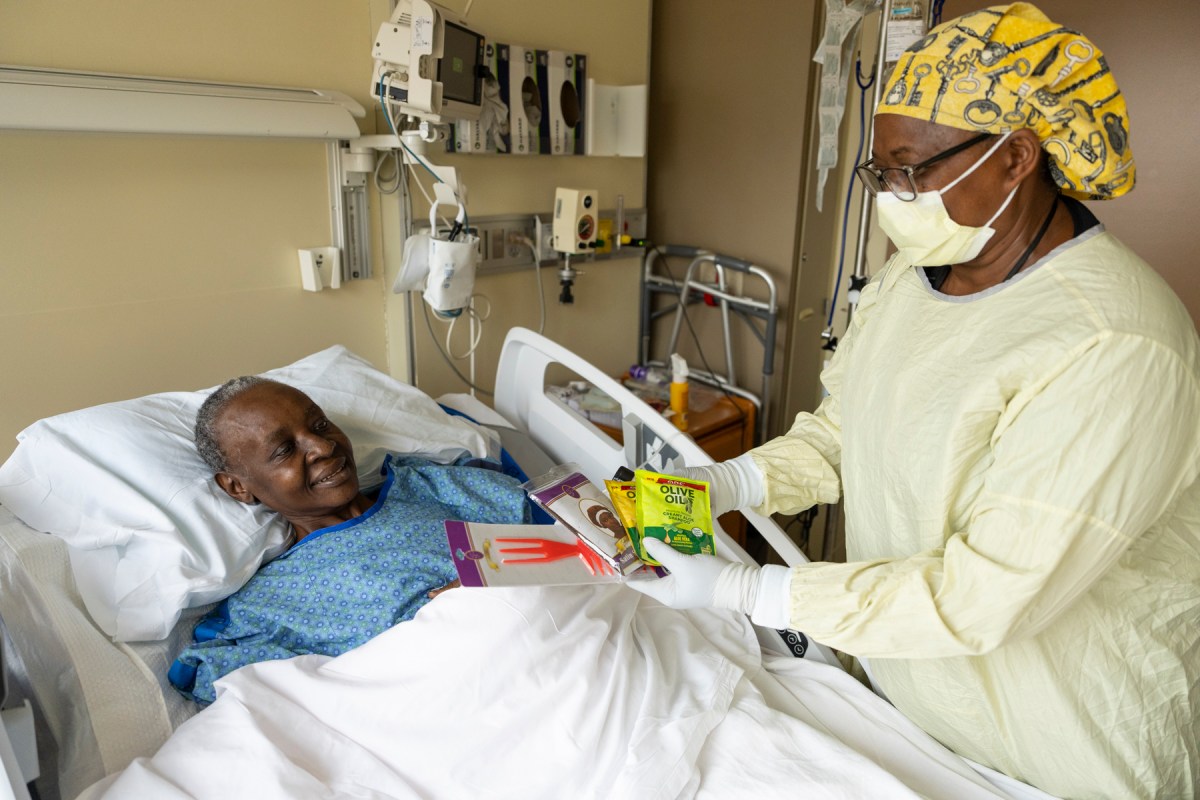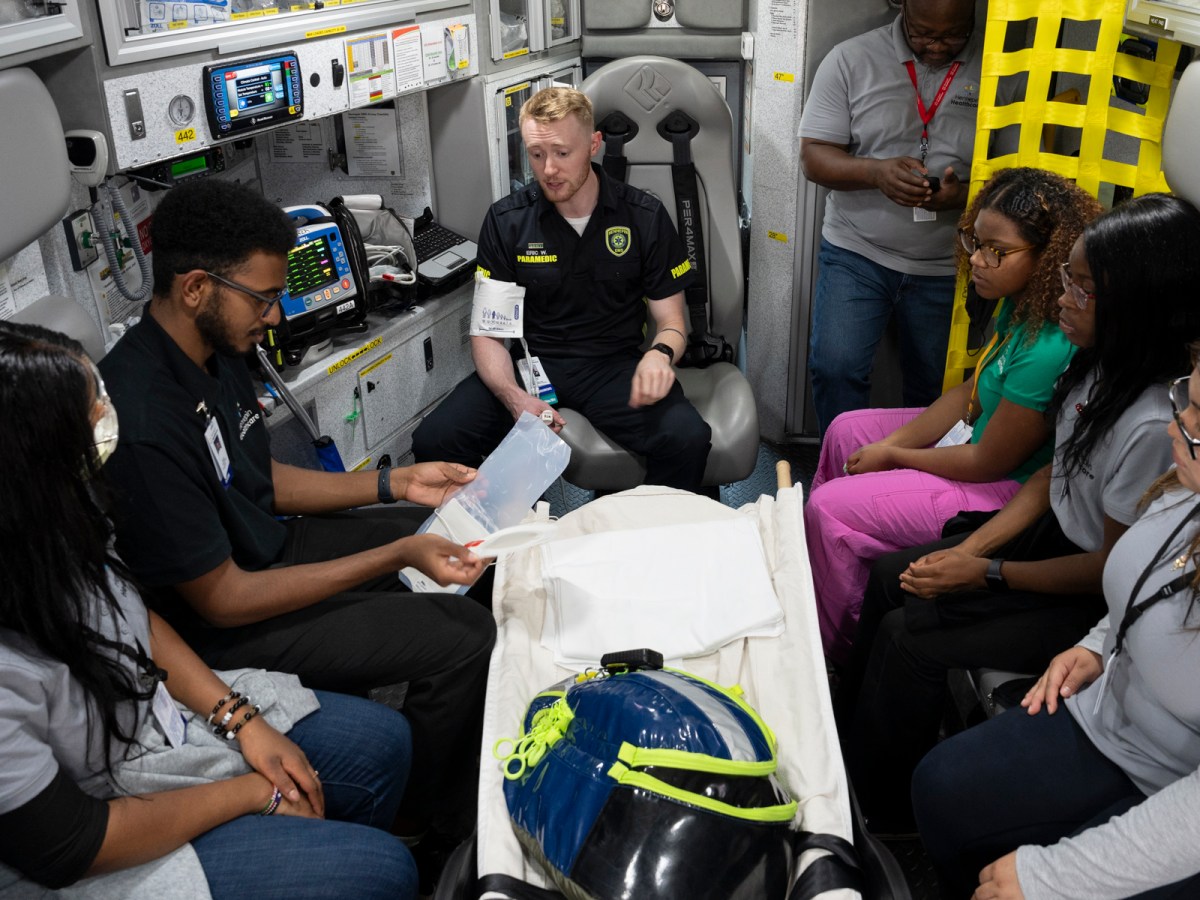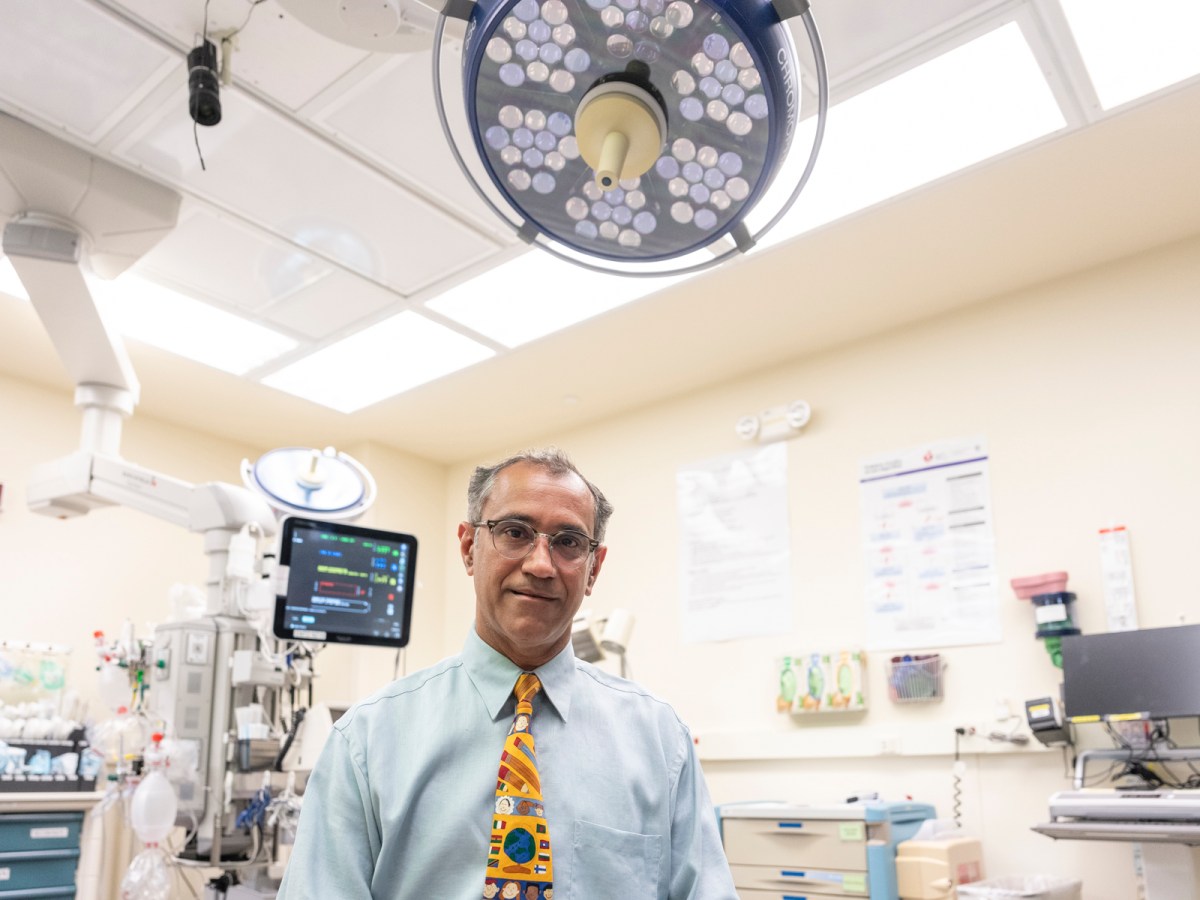Amanda Robinson is a frequent patient on Hennepin County Medical Center’s fifth floor, where she gets treated for a lifelong, chronic illness. That means she is quite familiar with the daily routines and the nurses who feel like family.
So she was surprised during her most recent stay at the Minneapolis hospital when a nurse offered her new hair-care products, including shampoo, conditioner, leave-in conditioner, and detangler that were appropriate for her textured hair, which she wears in locks.
“I’ve been going to this hospital most of my life, and I’ve never seen these products here,” she said. “It just shows that someone’s talking, and someone might be listening.”
Patients across Minnesota have been sharing similar experiences recently, as a handful of hospitals have begun to offer culturally appropriate hair- and skin-care products, including head caps and hijabs.
And though it’s not known how widespread the practice has become, Minnesota hospitals seem to be at the forefront of such efforts. As recently as 2019, an attempt by researchers from the University of Iowa to study the availability of culturally appropriate products in hospitals found that they weren’t available on a wide-scale basis anywhere in the country.
“They love the products,” said Tshilanda Nyembwe, a nurse in HCMC’s internal medicine department. “They are begging us not to stop because we are giving them what they use at home, and they’re happy…. We were taking care of their diagnosis with medication and physical therapy and occupational therapy, but we just missed the little thing that made the difference.”
Patient-inspired, grass-roots efforts
As hospitals increasingly recognize the need for culturally competent health care to improve outcomes and reduce racial disparities, many have adopted Diversity, Equity, and Inclusion initiatives to address obvious shortcomings such as language barriers and the lack of diverse staffing.
Now, some hospitals are discovering that seemingly smaller practices can also have a big impact. “Hospitals are uncomfortable places,” said Dr. Nneka Sederstrom, chief health equity officer at Hennepin Healthcare, which runs HCMC. “You don’t feel like yourself; you feel scared and nervous and vulnerable. And it’s the little things that make you feel safe and whole. We have not been allowing that sense of normalcy to be part of the experience for Black and brown patients.”
Several Minnesota hospitals decided to change their practices after a patient expressed a desire for a product that the hospital didn’t provide, and someone — often a nurse — decided to do something about it.
At HCMC, for example, a nurse who works on the hospital’s fifth floor was lunching with her colleagues when she mentioned a patient ‘s request for certain hair products. The nurse brought some of her own products from home, and soon the floor had a basket of products to offer patients.
Separately, Sederstrom’s team started providing gift baskets to Black and brown birthing moms. Sederstrom met Tianna Thompson, owner and founder of Twin Cities-based The Human Of Color Haircare, and Alicia Thomas of Butter Luv Aromatics, at a craft fair and asked if they could make smaller sizes of their products for maternity patients. The project, initially scheduled for one month, expanded when it proved to be popular.
Thompson said that when she approaches hospitals about supplying her products, almost everyone she talks to is surprised to learn of the needs of people with textured and curly hair. Her products range from hair bonnets to shampoo, oil, combs, even hair ties.
“I think it’s important that hospitals understand that there are textured- and curly-haired people everywhere, and when we are in stress, it is the smallest things that matter,” she said.
It’s the little things that make you feel safe and whole. We have not been allowing that sense of normalcy to be part of the experience for Black and brown patients.
Dr. Nneka Sederstrom, chief health equity officer at Hennepin Healthcare
Meanwhile, Susan Walters, a supply chain manager at Hennepin Healthcare, had been looking into a hospital-wide switch of products since 2019, when she heard that Children’s Hospital of Pennsylvania was planning to do so.
“It got me thinking, what do we have for personal care products for people of color?” she said. “I explored our catalog of supplies that we use and I found a wide-tooth comb. That’s it. For people of color, we had a wide-tooth comb.”
The hospital now offers 14 different, culturally appropriate products, from olive oil shampoo and condition to satin sleep caps.
“The whole hospital is utilizing them at a good clip,” she said. “People request them for their supply rooms.”
A ripple effect for other Minnesota hospitals
Hennepin Healthcare’s move has had ripple effects. When it made the switch, Allina followed suit, she said, since the buyers often collaborate and use the same distributor.
The Mayo Clinic’s efforts to offer culturally appropriate products also started with patients. Dr. Saranya Wyles, a dermatologist, said that when a nurse noticed that many patients didn’t have suitable products, the nurse alerted the Mayo Employee Resource Groups, which advocates for advancing diversity and inclusion efforts. When the group interviewed patients, they found that some in long-term care had cut their hair because they didn’t have access to the right products.
Last year, Mayo revamped its lineup of skin- and hair-care products and added education outreach for providers.
Similarly, Children’s Minnesota responded after a family expressed concern that their child’s hair hadn’t been cared for properly. The hospital also wanted to find a way to accommodate those who wear hijabs and headscarves. (To prevent self-harm, staff take away scarves from patients who check in for emergency mental health care.)
“As a Muslim woman and a woman of color myself, I want to make sure we offer appropriate products to patients and families,” said Mona Rippy, a change-management consultant at Children’s. “This is their home away from home, so how do we offer all of those products to everyone?”
Like the other local hospitals, when Children’s looked at the products offered by distributors, they came up empty-handed. So they too formed a task force to find and vet products that were culturally appropriate and met the hospital’s safety standards.
“When patients come in in crisis, we take away all of their belongings and hand them scrubs,” said Dr. Samreen Vora, the executive sponsor of Children’s employee resource group. “We take away their head scarf to keep them safe, but that means we’re also taking a piece of them away.”
Children’s now offers various personal care products, plus hijabs and head caps that meet the hospital’s requirements.
Patient satisfaction
Feedback so far has been resoundingly positive, the hospitals say. “I had a family attempt to pay me because they could not believe we would offer appropriate products to them free of charge,” said Heidi Shafland, a clinical nurse specialist in Children’s cardiac intensive care unit. “It was heartbreaking.”
The Mayo Clinic has also heard that patients are happy with the products, Wyles said, and its team plans to gather more information through surveys.
HCMC also saw how such a seemingly simple change could have a significant impact. Shortly after the hospital began offering the products to new moms, the company that conducts Hennepin Healthcare’s patient satisfaction surveys contacted the hospital: There had been a notable leap in patient satisfaction among Black maternal patients. What had they done differently?
“We were like, wait, what?” Sederstrom said. “The only thing we did was give them a chance to know that we see you, and give them things to help them feel normal.”
THE PRODUCTS
It hasn’t been simple to find suppliers of culturally appropriate products that also meet safety and size requirements, hospital buyers say In large part, this is because so few hospitals are doing it. Most of the hospitals put together groups of employees and patients to vet the products.
At the Mayo Clinic, Dr. Saranya Wyles also set up education modules, highlighting the needs of Black, curly, and textured hair, including misting and sealing, gel-free styling, satin pillowcases, and wide-toothed combs.
Now, if a nurse comes on, wondering how to care for patients with curly or textured hair, they can watch a video that goes through hair care and all the products, she said.

So what are the new products? Here’s a look at some of the items HCMC offers:
- Toshica’s Finest Satin Sleep Cap
- Toshica’s Finest Satin Durag
- Toshica’s Finest brush
- Toshica’s Finest bobby pins
- Toshica’s Finest 3-in-1 comb
- Toshica’s Finest rubber bands
- Cantu leave-in conditioner
- Cantu Kids Nourishing Tear-Free Shampoo
- Cantu Kids Nourishing Tear-Free Conditioner
- Aunt Jackie’s Instant Detangling Therapy
- ORS Olive Oil shampoo
- ORS Olive Oil conditioner
- Biocare Oil and Shea Butter lotion
Children’s Minnesota shared its current product list, which includes the following:

Angel Baby Oil
Be Serene shampoo and body wash


Be Serene conditioner
Conscious Coconut coconut oil


Comb
Styling brush


Head covering with Children’s logo
Hijab

For smaller vendors such as Thompson’s The Human of Color Haircare, working with a big hospital system like Hennepin has changed the direction of the company, she said.
“I don’t see it as a financial gain necessarily, but now we’re able to reach more of the community in unique spaces,” Thompson said. “And I think it’s important that hospitals understand that access to hair care should be a necessity, that it’s as important as a toothbrush.”






